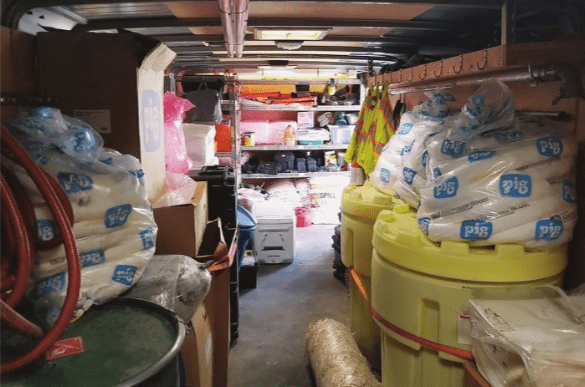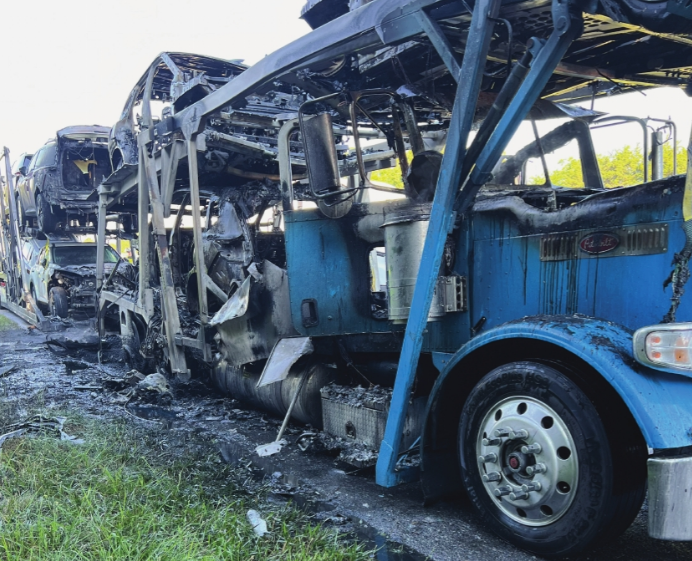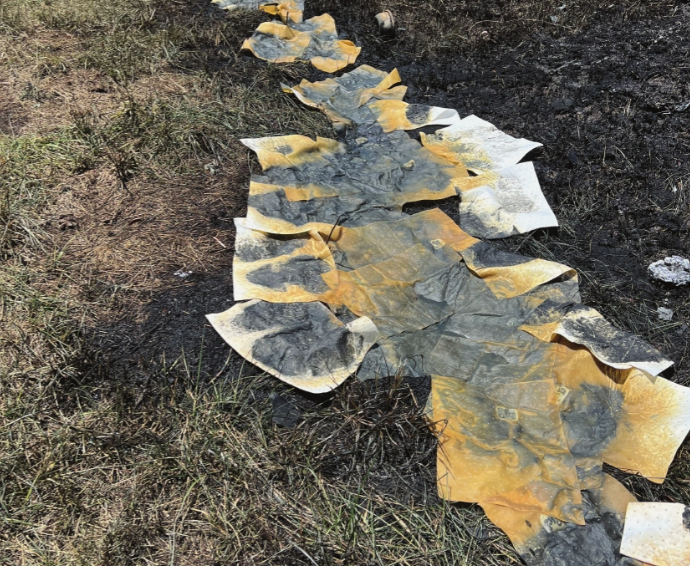Audio Article – Critical Cleanup: Mopping Up Hazardous Material Spills
Critical Cleanup:
Mopping Up Hazardous Material Spills
from the September 2022 Issue of Tow Times Magazine

Inside view of Casper’s Environmental LLC’s hazardous response trailer
When tow operators respond to spill accidents involving everything from passenger vehicles and car haulers to large tankers hauling chemicals, a hazardous material (hazmat) leak can threaten the safety of the incident scene and surrounding area.
“The majority of our spill cleanups after accidents are diesel fuel,” noted Mike Phillips, owner of All American Towing & Recovery Inc. (allamericantowingtx.com) in Justin, Texas. “Saddle tanks on eighteen-wheelers rupture quite often in crashes. This can require hard surface and soil cleanup, which requires excavation.”
Larger spills require more resources. In Greeneville, Tenn., Jimmy Collins of Casper’s Body Shop & Wrecker Service (caspers bodyshop.com) recalled a vehicle-on-tractor-trailer collision that occurred. “The tractor-trailer driver had just filled up, so he had probably 200 gallons of fuel onboard,” said Collins. The collision ruptured the truck’s fuel tank and spilled fuel over three lanes of a local interstate highway.
“With this type of response,” explained Collins, “you know as well as I do that the interstate has to be opened. Sometimes you have to deal with the spill before you deal with the wreck. The highway patrol doesn’t have time to wait, nor do you if you’re sitting in traffic.” Because they offer cleanup services for large spills like this one, Collins and his crew dried the road surface within two hours, sufficiently so that one lane could be opened to traffic again.
A Need for Large-Scale Response
Another recent vehicle crash illustrates the need for expanded hazardous material cleanup services on-scene. As illustrated in the accompanying photos, an auto hauler carrying nine new SUVs on Interstate 81 in Tennessee burst into flames at the right front rear axle. The driver pulled over and grabbed his fire extinguisher, but was unable to put out the fire.
“The fire department responded,” recalled Collins. “By the time they got there, the truck and the three cars on the trailer were burned completely. If you picked the truck up, the axles would fall off. That’s how badly it burned.” Meanwhile, two SUVs on the trailer also went up in flames, leaving only four drivable vehicles.

This auto hauler erupted into flames while on I-81 in Tennessee. The tractor and multiple vehicles on the trailer burned.

Casper’s Environmental LLC, put down absorbent pads, brought in barrels and pumped out both 150-gallon fuel tanks.
Collins’ cleanup company, Casper’s Environmental, was tasked by the highway patrol as part of a rotation to clean the interstate, which was completely blocked to traffic. To open one lane, “We separated [the truck and trailer] using two large wreckers to get them off the road,” said Collins. “We put pads down, brought in barrels, and pumped out both 150-gallon fuel tanks. We dried out the tanks, removed the SUVs, and got the burned debris and melted aluminum off the shoulder.”
A Growth Business
This type of spill cleanup is beyond the reach of the average towing company, so owners like Phillips and Collins have expanded their response capabilities. “We added [cleanup services] out of necessity,” said Phillips. “We work a vast number of truck wrecks as a company. You can get out there [to an accident] and wait three to four hours for a hazmat company. It made more sense to open our own service and train our people to do it.” Phillips’ wife Lainie runs their hazmat cleanup provider, North Texas Spill Response (northtexasspillresponse.com), while he serves as the vice president. The company opened its doors five years ago.
Collins’ entry into providing cleanup services tracked a similar path. Earlier in his towing career, Collins observed cleanup firms at work during incidents such as tractor-trailer wrecks. “I paid attention to what was involved and what it cost on that side of the business,” he recalled. “They were finalizing cleanup of the scene and putting things back to pre-accident condition. I decided one day to pursue that service alongside my wrecker service.”
Collins eventually spun off his cleanup response service, Casper’s Environmental LLC, from his company. “We decided to make a capital investment into the environmental business. We needed training, so I contacted Perry Beaty.”
Employee Training
Tow operator-turned-trainer Beaty runs the Denver, N.C.-based Hazmat Responder Network (hazmatrn.com), which offers HRNT-1001, a 40-hour program for towing and recovery professionals who want to learn how to mitigate and clean up incidents involving hazardous materials. Course topics include regulatory requirements, hazard identification and spill control, documentation, scene safety and incident command and management. The course fulfills the OSHA Hazardous Waste Operations and Emergency Response (HAZWOPER) training requirement.
“We trained everyone in the company to respond to hazardous containment-type spills,” said Collins. Some employees prefer to drive tow trucks and perform basic hazardous material cleanup, but most are dual-trained in performing basic and advanced cleanup services. Beaty’s HRNT-1001 course, which was conducted in-house at Casper’s, began on a Thursday night and ran all day Friday through Sunday. Training included classroom instruction and on-the-job training, with refresher classes in the future.
Mike and Lainie Phillips of All American Towing & Recovery originally sent their supervisors and senior employees through training, and gradually expanded that part of their business until it was large enough to spin off into its own company, North Texas Spill Response. Today, all employees at North Texas Spill Response receive the 40-hour HAZWOPER equivalent course through the Hazmat Responder Network along with incident commander training and annual refresher training.
Lainie Phillips also has her employees take the Hazmat Responder Network’s cargo tank awareness course, which focuses on transport tank trailers that haul Class 3 (flammable liquids), Class 6 (poisonous/toxic) and Class 8 (corrosive) hazardous materials.
Vehicles, Equipment and Protective Gear
Opening a cleanup shop can put a large dent in a company owner’s wallet. “It depends on what you want to do,” said Collins. “Simple small spills? Or large spills?” To work minor incidents of 20- to 50-gallon spills that don’t run into the drainage system, Collins suggests an investment of around $50,000 for a used truck and an equipment trailer. For towing companies that want to go full-bore and tackle large cleanup projects, Collins said that initial costs can be as high as several hundred thousand dollars.
The vehicle fleet at North Texas Spill Response includes excavators, skid steer loaders and 18 roll-off dumpsters. “Then you have your standard pumps, grounding and bonding equipment, and personal protective equipment (PPE),” said Mike Phillips.
With regard to PPE, OSHA designates four protection levels for employees working hazardous material cleanup. To outfit an employee with proper PPE to handle level A (highest protection) to level D (lowest protection) responses, “You’re looking at probably $15,000 a person, which can include equipment such as a self-contained breathing apparatus,” explained Phillips.
An Added Bonus
One advantage to owning a cleanup operation is providing assistance to non-roadside spills in addition to roadside incidents. “We can go out to a fixed site,” noted Collins. “For example, if a local bottling plant spilled something, or if a company filled a pit that now needs to be cleaned up.”
Mike Phillips agrees: “We also handle dock spills where forklifts have burst barrels open, overflows on tanks, anything and anywhere you can imagine.” His company’s relationship with local fire departments has led to additional business. “If their teams go out to something that has hazardous materials — one-ton containers of chlorine, or ruptured nitrogen compressor stations — they immediately call us.”
Is It Worth It?
For towing company owners who are considering expanding into spill cleanup, Collins said there’s one important question to answer: “What do you want to do, and how many people do you have?” Scope is a major factor in providing hazardous cleanup, and not all towing companies can handle larger and more complex spills. “It all depends on the extra resources you have to deploy,” he noted.
“No matter how many people I have and how big my company is, spills stress the system,” said Collins. Responding to a major roadside incident can require all or the majority of a company’s employees and equipment.
Nevertheless, Collins recommended that towing company owners seriously consider adding hazardous cleanup to their standard wrecker service. “They go together,” he said. “It’s a hand-in-hand extension of your business.”
“You can handle cleanup at your crashes only, or you can turn it into a profitable business,” noted Mike Phillips. “It is not a cheap portion of the business to get into. It is very cost-heavy to start. But if you do it correctly, it has very good margins.”